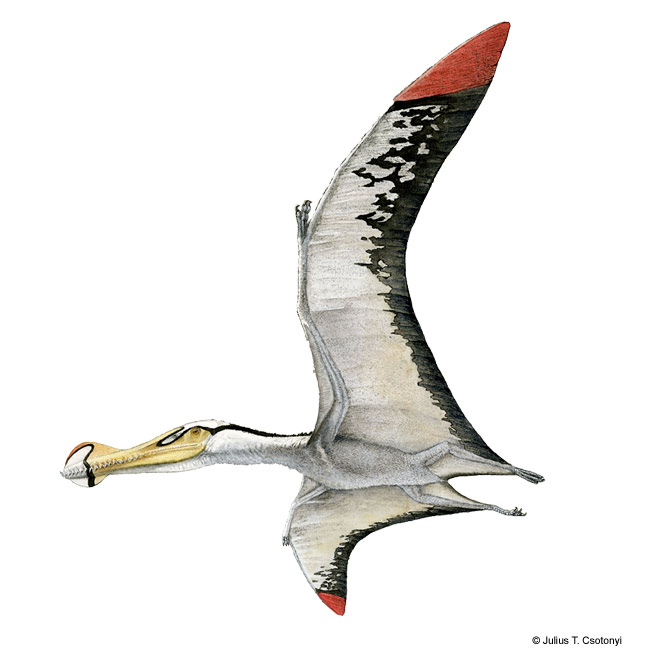[Recent Entries][Archive][Friends][User Info]
Below are the 2 most recent journal entries recorded in the "Сообщество, посвящённое ра" journal:| June 7th, 2014 | |
|---|---|
| 02:53 pm [industrialterro] [Link] |
Liaoningopterus Liaoningopterus, sometimes misspelled "Liaoningopteryx", was a genus of ornithocheirid pterodactyloid pterosaur from the Barremian-Aptian-age Lower Cretaceous Jiufotang Formation of Chaoyang, Liaoning, China. The genus was named in 2003 by Wang Xiaolin and Zhou Zhimin. The type species is Liaoningopterus gui. The genus name is derived from Liaoning and a Latinised Greek pteron, "wing". The specific name honours Professor Gu Zhiwei, an invertebrate specialist who has pioneered the study of the Jehol Biota. The genus is based on holotype IVPP V-13291, a crushed partial skull and skeleton including the jaws, teeth, a cervical vertebra, and bones of the finger supporting the wing. It was a large pterosaur — the largest known from China at the time of description — with a skull length estimated at 61 cm (24 in), and a wingspan estimated at five metres (16.4 ft). The skull was long and low, bearing low crests close to the tip of the beak on both lower and upper jaws. The snout crest was twelve centimetres long, was symmetrical in form and had a maximum height of seventeen millimetres. The edge of the upper jaw was very straight. The teeth were only found at the anterior end of the jaws. They were elongated but robust, generally increasing in size from the back to the front. The fourth tooth in the upper jaw is with a length of 81 millimetres the largest known for any pterosaur. It is exceptional in size compared to the other teeth of Liaoningopterus also, the longest tooth in the lower jaw having a length of 41 millimetres. Tooth length in the specimen is very variable, which the authors explained by the presence of recently erupted replacement teeth. There were twenty pairs of teeth in the upper jaws and thirteen or fourteen pairs in the lower jaws. The preserved cervical vertebra has a centrum length of 46 millimetres and a centrum height of 34 millimetres. From the wing bones pieces of the first phalanx can be recognised which had an estimated total length of about fifty centimetres. The authors described Liaoningopterus as being probably a piscivore, due to the long, pointed snout. Wang classified Liaoningopterus as a member of the Anhangueridae, mainly because of the crests. This opinion was restated by him in 2005. In 2006 Lü Junchang published a cladistic analysis showing Liaoningopterus to be a basal member of the Anhangueridae; in 2008 an analysis by Ji Qiang had Liaoningopterus in a trichotomy with Anhanguera and Tropeognathus. Tags: Вымершие рептилии, Мел, авеметатарзалии, аньянгуэриды, архозавроморфы, архозавры, диапсиды, монофенестраты, орнитохейройды, птеранодонтойды, птеродактили, птерозавры |
| April 23rd, 2014 | |
| 01:42 pm [industrialterro] [Link] |
Anhanguera Anhanguera (meaning "old devil") is a genus of pterodactyloid pterosaur known from the Lower-Cretaceous (Aptian age, 112Ma) Santana Formation of Brazil, with referred specimens found in the Upper Chalk Formation and Cambridge Greensand of the UK (up to the late Cenomanian age, 94Ma). This pterosaur is closely related to Ornithocheirus, and belongs in the family Ornithocheiridae within its own subfamily, Anhanguerinae. Anhanguera was a fish-eating animal with a wingspan of about 4.5 m (15 ft). Like many other ornithocheirids, Anhanguera had a rounded crests at front of its upper and lower jaws, which were filled with angled, conical but curved teeth of various sizes and orientations. Like many of its relatives, the jaws were tapered in width, but expanded into a broad, spoon-shaped rosette at the tip. It is distinguished from its relatives by subtle differences in the crest and teeth: unlike its close relatives Coloborhynchus and Ornithocheirus, the crest on the upper jaw of Anhanguera did not begin at the tip of the snout, but was set farther back on the skull. Like many ornithocheiroids, (most notably the pteranodonts but also in ornithocheirids such as Ludodactylus) Anhanguera had an additional crest protruding from the back of the skull. However, it was reduced to a small, blunt projection in these animals. A study in 2003 showed that Anhanguera held its head at an angle to the ground due to its inner ear structure, which helped the animal detect its balance. There are several recognized species of Anhanguera. A. santanae and A. blittersdorfi are known from several fragmentary remains including skulls from the Santana Formation of Brazil. A. cuvieri and A. fittoni, initially described as belonging to the genus Pterodactylus and then Ornithocheirus, are from a slightly later period (Albian) from England, while fragments of pterosaurs that may have affinities with Anhanguera have also been found in Queensland, Australia. The well-known species A. piscator has been redescribed as belonging to the genus Coloborhynchus (Veldmeijer, 2003). Anhangueridae is a group of pterosaurs within the suborder Pterodactyloidea. They were among the last pterosaurs to possess teeth. A recent study discussing the group considered the Anhangueridae to be typified by a premaxillary crest and a lateral expansion in the distal rostrum. The same study presented a cladistic analysis, for which an "Agreement subtree" was calculated. The Anhangueridae was found to be sister taxon to the large crested "Tropeognathus". ( Read More ) Репродукции (1, 2, 3, 4, 5, 6, 7, 8): ( Read More ) Ископаемые останки (1, 2, 3, 4, 5): Tags: Вымершие рептилии, Мел, авеметатарзалии, аньянгуэриды, архозавроморфы, архозавры, диапсиды, монофенестраты, орнитохейройды, птеранодонтойды, птеродактили, птерозавры |












